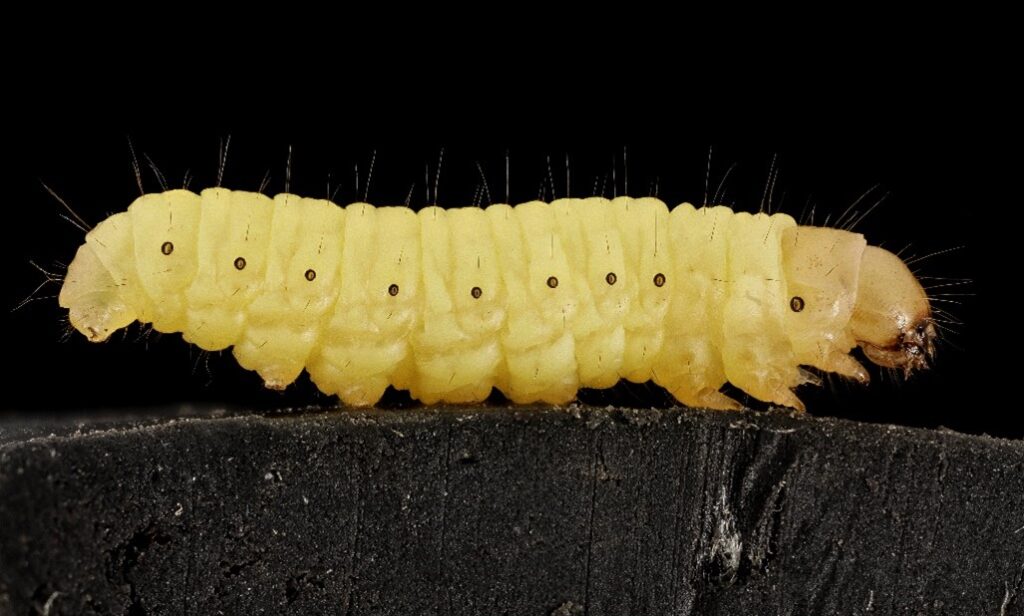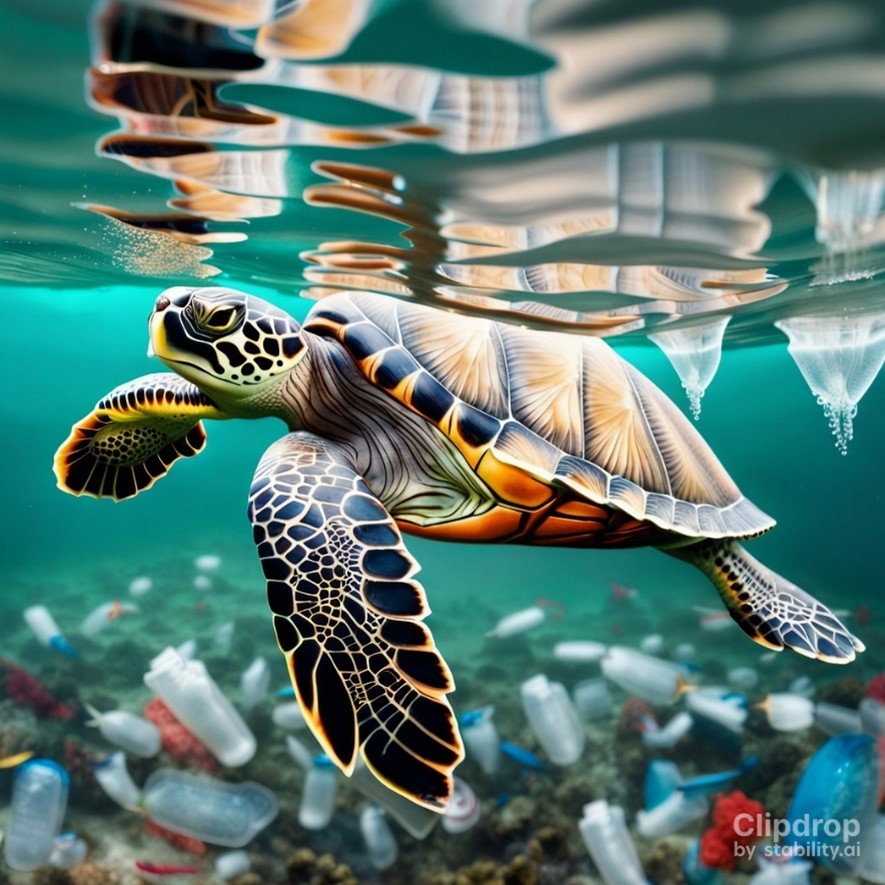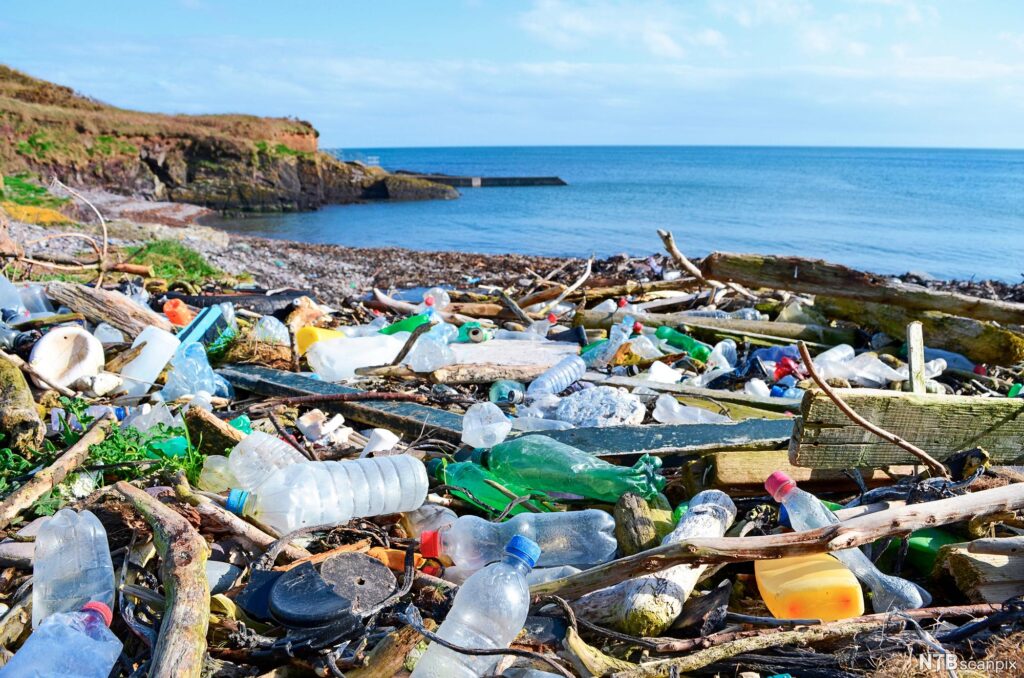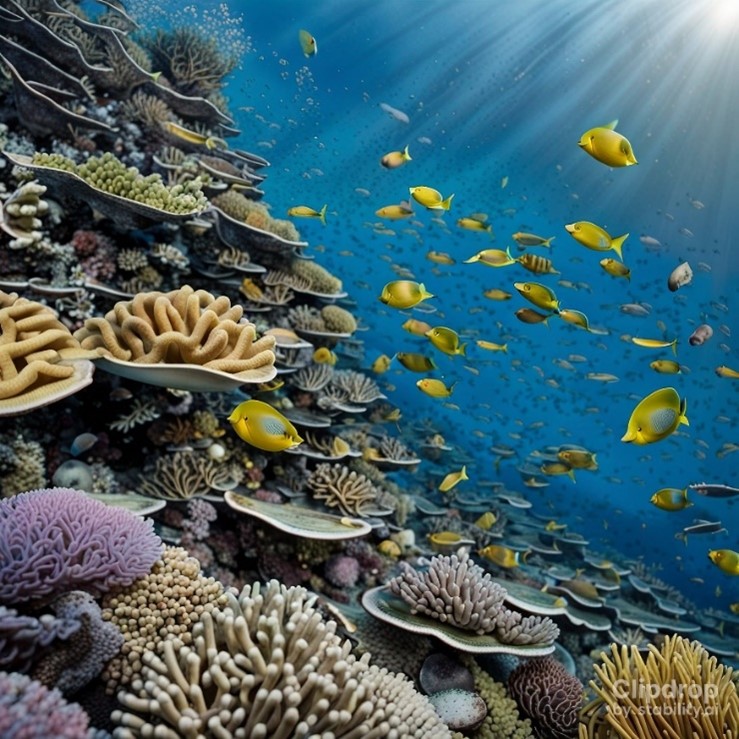
How close are we to a solution? And could caterpillars be part of the answer? Image: Sam Droege.
Plastic, an artificial product made from non-renewable petroleum, has achieved extensive usage due to its sturdiness, lightweight properties, and cost-effectiveness.
However, rapidly escalating plastic pollution has emerged as a major global issue, imposing significant perils upon wildlife and ecosystems. The long life of plastic in the environment, requiring centuries to decompose, has led to the entanglement and asphyxiation of marine creatures, while fragmentation into microplastics has infiltrated the food chain. Additionally, plastic contributes to climate change through the emission of greenhouse gases in its production.
To combat this crisis, collective efforts are underway that aim to reduce plastic consumption, promote recycling, clean up existing waste, and invest in biodegradable alternatives.

Plastic litters both the sea floor and surface. Image generated using Clipdrop.
Plastic waste has become a critical issue worldwide because it consists of non-biodegradable synthetic polymers designed to be exceptionally resistant to deterioration.
Unlike organic substances that naturally break down over time, plastics are engineered for enduring strength and longevity. While this durability may offer benefits for specific uses, it presents a substantial challenge in terms of waste disposal. Plastics can persist in the environment for hundreds of years, accumulating in landfills, oceans, and various natural ecosystems.
Additionally, over time, larger plastic items can break down into smaller fragments known as microplastics, which are less than 5 millimeters in size.
These microplastics can easily enter ecosystems, including water bodies, where they can be ingested by marine life and other organisms. Microplastic ingestion can lead to suffocation and internal injuries, causing harm and even death to wildlife. Plus, the accumulation of plastic waste in marine ecosystems disrupts their delicate balance, and ultimately affects human health, as microplastics can enter the food chain through consumption of contaminated seafood and water.
Finally, the production of plastic requires significant amounts of fossil fuels, contributing to greenhouse gas emissions and climate change.
Federica Bertocchini, a molecular biologist at the Spanish Research Council (CSIC), states that despite ongoing efforts to mitigate environmental damage, vast quantities of plastic waste persistently accumulate in landfills and oceans.
Conventional approaches like landfill disposal, incineration, and mechanical recycling have proven inadequate in addressing this predicament.
In a recent study, Dr. Bertocchini showed that the robust structure and water-resistant nature of plastics impedes degradation by microbial activity, hindering bacteria and fungi from colonizing and utilizing plastic materials as an energy source. Subjecting plastics to heat or UV light renders them more amenable to breakdown, as oxidation of the polymer yields smaller compounds that microorganisms can metabolize as carbon.
Nevertheless, certain bacterial strains have been observed to grow on untreated plastic.
This led Dr. Bertocchini to explore the potential of wax worms, which possess enzymes in their saliva capable of dismantling the chemical bonds of plastic and transform it into a beneficial substance for the worms. This discovery could hold great potential.
A promising new approach involves biological means of plastic degradation.
Meet The Plastic-Eating Worms | Planet Fix | BBC Earth Lab
Dr. Bertocchini explained to the BBC that the enzymes present in the saliva of wax worms are called phenol oxidases, and they can quickly oxidize and degrade PE (polyethylene, the most widely used plastic in the world).
This challenges the assumption that gut bacteria are solely responsible for plastic degradation in insects.
The exact mechanism and the interplay between enzymes and gut bacteria remain unknown, emphasizing the need for further investigation. It is possible that the enzymes prepare the plastics for microbial degradation, but specific plastic-degrading bacteria have not been identified in the gut microbiota of these insects. Further study is required to fully understand the function and potential applications of these enzymes in plastic degradation.
Enzymes, which can speed up chemical processes without being consumed themselves, are being studied to understand their ability to break down plastic.
Another recent development in the field of biological means of plastic degradation is in a recent study conducted by researchers from the Norwegian University of Science and Technology, led by Kristina Hellesnes.
They are focusing on enzymes from bacteria and fungi that can efficiently break down plastic and are working to enhance their plastic degradation capabilities. They are also investigating proteins with special binding properties to improve enzyme attachment to plastic. However, the researchers emphasize that relying on enzyme-based solutions should not provide a reason to increase plastic production. Instead, they advocate for investing in biotechnological alternatives and reducing dependence on plastics from fossil sources to achieve a more sustainable future.
The Quantum Record reached out to Dr. Bertocchini, to ask her a few questions about biological means of plastic degradation.
TQR: Can you discuss how scalable is the method for plastic degradation using biological means (such as wax worms)? Would we have to “farm” these little beings, or can the enzymes be artificially created in the lab?
Dr. Frederica Bertocchini: “Scalability is the next question about this methodology, or any methodology, actually. But as far as polyolefin bio-degradation goes, I think that a big step forward was the discovery that actually this kind of enzymes exists, because this quest for enzymatic degradation of polyolefins such as polyethylene (PE), has been going on for decades, with no results. This point is important. We need to make the process rentable, applicable, or whatever adjective we want to use.
The first thing is to produce these enzymes in large scale. Would it be possible? We will see, but we have to try hard, with all our means. Biotechnology does wonderful things, with mutagenesis, and improving of enzymes production, stability and sometimes, efficiency. If we do not do that (to be read as: if no funding is disposed in this direction), then it is pointless to continuing investing in this quest for enzymes, as there will always be the need of optimization for a scaling up process, with all the risks of this matter.
Farm of worms: no, not really, actually I am against it, and I have always been. These worms, as all the others capable to degrade plastics, cannot eat plastics, they can degrade it to a certain extent but without recovering energy out of it. The feces of these small animals will contain microplastics, we do not want that. We have the enzymes, we need to produce and apply them directly, without using the live animals.”
TQR: What message would you like to make louder concerning the issue of plastic pollution and plastic degradation?
Dr. Frederica Bertocchini: “My message is that we need solutions, not a single one, but as many as we can find, to be applied in a concerted way. We have mechanical recycling: I am not a big fan of this methodology, I have doubts about its efficacy, however even if it worked, it would not be enough. We would need to improve it, both the efficacy and the extent.
“We have the chemical methodology, very energetically expensive and polluting, but worth investing. We might combine chemical with bio, for example, without the need of a contraposition, funding-wise, as I often encounter. We need to cooperate and collaborate to solve the problem. And of course, use less whenever possible, this goes without say. It is crazy the amount of plastic that is produced, and hence, used. On this front, a good educational program would not be bad, either, as for any other environmental issue we are facing today.”

Oceans are filling with islands of plastic waste, resulting in beaches such as this in the county of Cork, Ireland. Image: NDLA .
Transitioning Plastic Production and Use to a Sustainable Future
In a recent paper published in Nature Sustainability, Marvin Bachmann and co-authors (2023) examined the sustainability of the global plastics industry within the context of planetary boundaries. They found that current circular strategies, which include recycling technologies and biomass utilization, fall short of achieving absolute sustainability and transgress sustainability thresholds by up to four times.
However, the study suggests that by improving recycling technologies and incorporating biomass and CO2 utilization in plastics production, it may be possible for the plastics industry to comply with safe operating space boundaries by 2030.
Nevertheless, the research highlights that even enhanced recycling alone cannot keep up with the projected growth in plastics demand until 2050. Achieving absolute sustainability in the plastics industry will require fundamental changes in both production and consumption methods. The study emphasizes the urgent need for a transition towards sustainable plastics and the mitigation of plastic pollution, habitat loss, and greenhouse gas emissions to address this planetary crisis.
Will insects hold the key to finding a new way to dispose of plastics?
Perhaps. But, ultimately, reducing plastic pollution requires a multi-faceted approach that includes reducing overall use of plastic, increasing the use of alternatives, promoting recycling, improving consumer education and implementing policies like single-use plastic bans such as Canada recently implemented.
By taking these steps, we can work towards a more sustainable future and protect our planet for generations to come.

The future demands that natural systems remain natural, and that we find solutions to remove our pollution. Image generated using Clipdrop.
Craving more information? Check out these recommended TQR articles:
- Saving the Planet: Nobel Prize Recognizes Climate Science, but Will Mindsets Change in Time to Sustain Nature’s Potential and Value?
- Mega-trees: The Critical Role and Vulnerabilities of Nature’s Giants in Forest Ecosystems and Climate Change Mitigation
- New Light on Nature’s Technology Connects Plant-Microbe Interactions and Climate Change
- Financing Climate Change and Abolishing the Obsolete Zero-Cost Assumption for Natural Resources
- A Technological Proposal for Trust and Transparency in Environmental Standard-Setting and Monitoring



